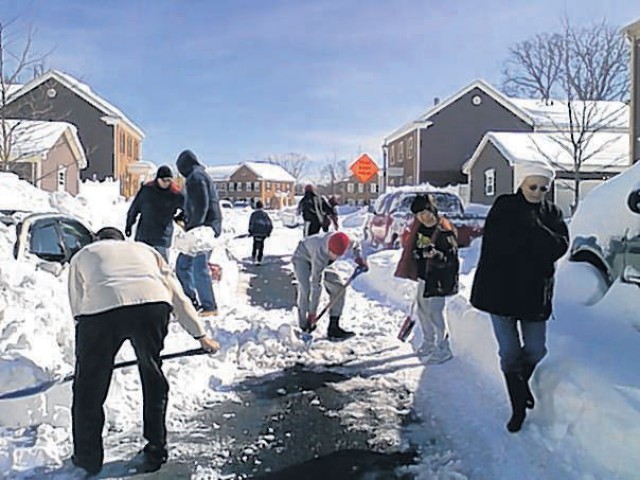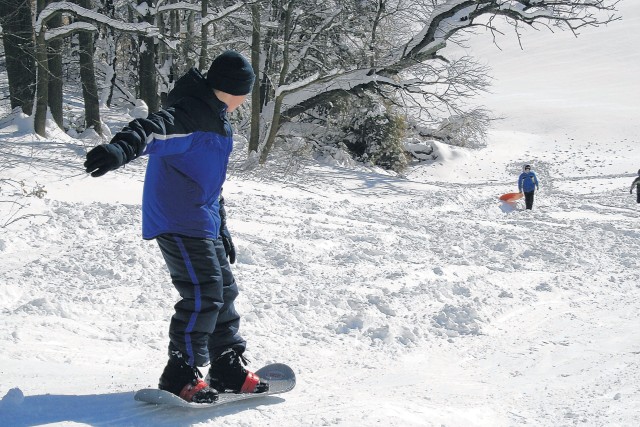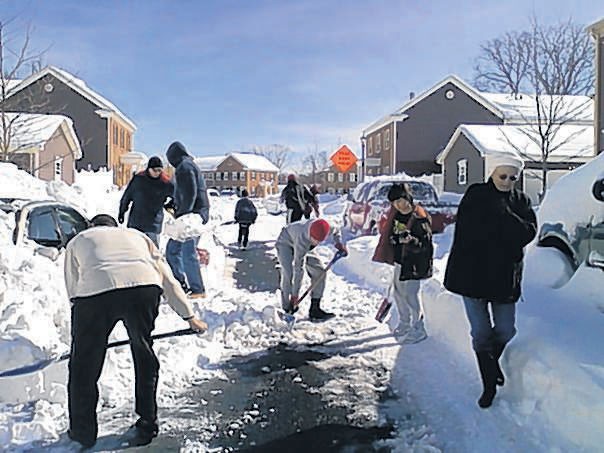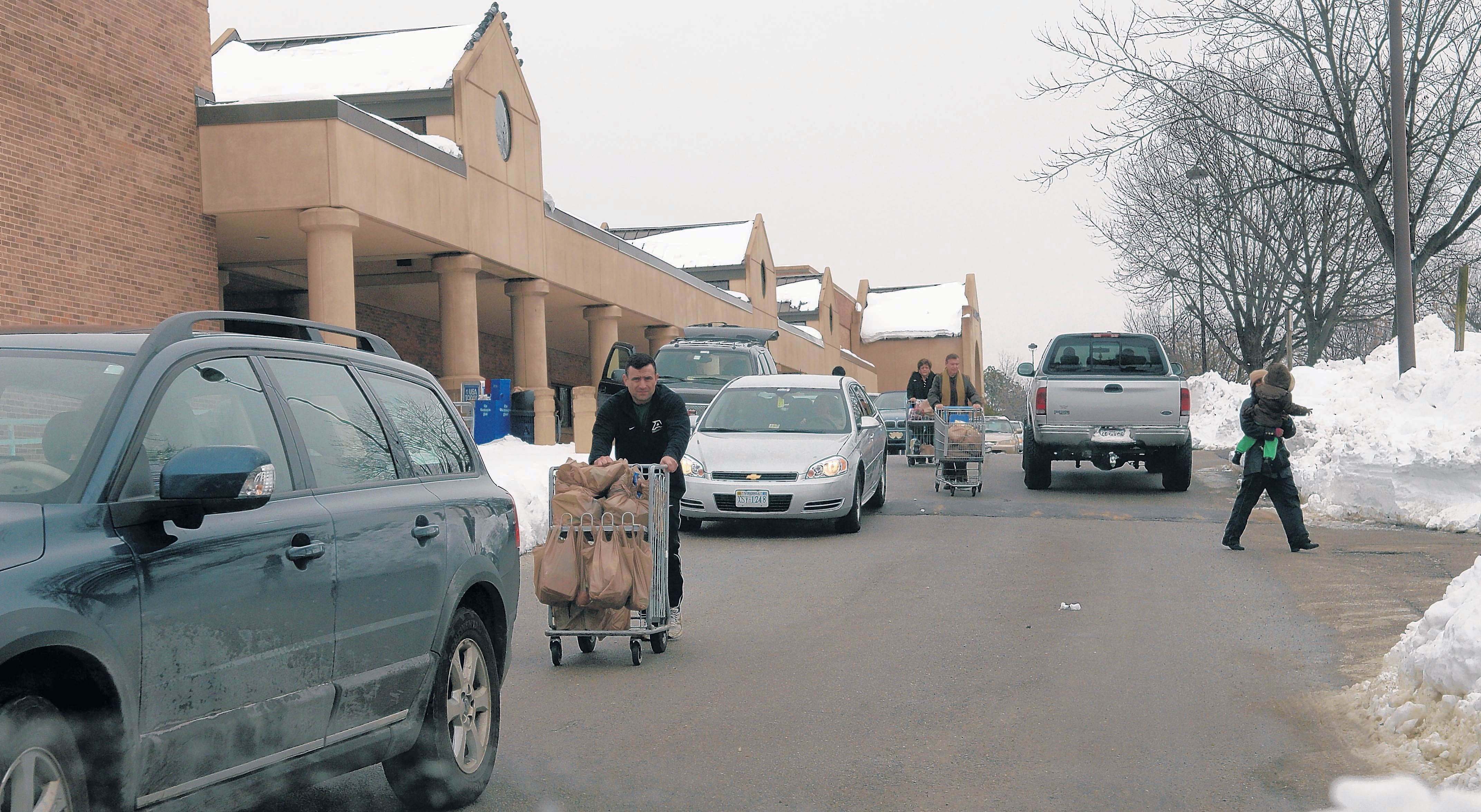FORT BELVOIR, Va. -- Blizzard of 2010 hits post; community, agencies join hands to dig out
For the second time in less than 60 days, Belvoir and Northern Virginia were hit with major snowstorms. The first, Dec. 18 to 20, left the region covered in as much as 20 inches of powdery snow in some areas, while the historic storm that blew in Friday caused severe problems for citizens with roads out of service and many power outages.
Between the two blizzards, both caused by ferocious Nor'easters, strong areas of low pressure from the Gulf of Mexico or the Atlantic Ocean which moved up the East Coast, residents were hit with a small, but potent, storm Jan. 29 and 30 that coated the region with a 10-inch blanket of snow and ice.
On Fort Belvoir, snow accumulation totaled 18 inches in December's storm, four inches in January and 19A,A1/2 inches Friday.
Additionally, at press time, the region is coping with its fourth winter storm. According to meteorologists at Belvoir's Davison Army Airfield, at press time, six inches of snow had accumulated but they said to expect as much as 13 inches.
Recognized officially as the Blizzard of 2010, and dubbed "Snowmageddon" by news agencies, Friday's storm dropped as much as 24 inches of wet, heavy snow on roads and structures, bogging down major interstate highways and stopping public transportation, such as D.C.'s Metrorail system.
Belvoir's Installation Operations Center estimates about 60 people, using 18 snowplows, five bucket loaders, two road graders and two large dump trucks, worked around the clock to clear roads for travel and patrols from the Directorate of Emergency Services provided constant surveillance of the situation.
But, even before the first flake fell, Belvoir established a plan to make its roadways accessible, as much as possible and as soon as possible.
"[Early] planning for this storm allowed us to pre-position key members on post to reduce response time and our team was here to conduct the mission prior to the first flake hitting Belvoir," Installation Commander Col. Jerry Blixt said.
"We placed teams from Dominion Power, the dining facility, FMWR, and snow removal personnel on post. I'm convinced this saved many from more extensive power outages, ensured Soldiers were fed, assisted in clearing roads faster, and contributed to the overall safety of the work force," Blixt said.
Although the storm presented challenges different from December's, Blixt said he was confident in the staff and emergency workers to meet the challenge.
"This snow was wet and heavy.,and finding a place to put it posed another challenge," Blixt said. "Our snow removal crews; operations; law enforcement; firefighters; Morale, Welfare and Recreation; Public Affairs Office; Pinnacle and Dominion Power all have done an outstanding job.
"I'm grateful to those individuals and teams for their remarkable efforts to care for Fort Belvoir and our community," Blixt said. "We're fortunate to have such dedicated team members working with us here on Belvoir."
Nancy MacNamara, director of Plans, Training, Mobilization and Security, said their working relationship with DES and the Directorate of Public Works enables the process to go smoother during snowstorms.
"DPTMS, through the [IOC], works hand-in-hand with DES and DPW during a snow emergency, by maintaining status of the installation, much of it reported by DES, and passing to DPW where resources are needed to maintain installation safety and security," MacNamara said.
"This snow event kept two IOC operators per shift entirely engaged in response oversight. DPW has combined its operations center with the IOC, so we have one, centralized point for receipt, analysis and execution of requirements. I can't say enough about the tireless efforts of all involved," MacNamara said.
Belvoir's PAO used a wide range communication tools to update post residents on road conditions, hours of operation for essential stores and organizations and other changes.
In addition to the normal channels of notifying television and radio stations and updating the installation's home page, Belvoir also relied heavily on social media to get the word out.
Some of the social media used were Facebook, Twitter and an e-mail listserv.
Don Carr, director of public affairs, estimated that the Belvoir Facebook page saw around 1,000 new friends sign up during the snowstorm to keep updated on current information about the installation's status.
"Facebook allowed the community to communicate with the garrison officials and hear any concerns regarding situations residents were encountering," Carr said. "I was able to, on several occasions, take a comment from Facebook to head plowing or hospital officials and get an answer almost immediately to post back on Facebook.
"I also discovered that, during the extended power outages, people were still checking Facebook through their cell phones and Personal Digital Assistants," Carr said.
Many of the Belvoir residents who used Facebook found it to be their best avenue for important information.
As the post cleaned up from the last storm and faced the next wave of bad weather, Blixt said safety remained the number one priority for garrison officials.
"Decisions as to the installation's status are made with careful consideration to our ability to safely host the work force with accessible roads, parking areas and walkways," Blixt said. "As we attack our snow removal as an operational mission, our number one priority remains safety for our crews and community. We also take a hard look at the surrounding communities, road conditions, school closings, forecasts, and consideration to a mainly commuter work force."






Social Sharing